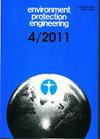Equilibrium, kinetics and thermodynamic study of the adsorptive removal of methylene blue from industrial wastewater by white cedar sawdust
IF 0.4
4区 环境科学与生态学
Q4 ENGINEERING, ENVIRONMENTAL
引用次数: 2
Abstract
The study evaluated the adsorption potential of white cedar sawdust (WCS) for dye removal. WCS was chosen from five preferred, abundant waste biomasses from Pakistan. Various parameters such as contact time, adsorbent dose, dye concentration, pH, and particle size were optimized for methylene blue (MB) dye adsorption. The adsorbent was characterized by FTIR, SEM, EDX and BET analyses. The surface area of the adsorbent was 1.43 m 2 ·g –1 and pore volume was 0.000687 cm 3 ·g –1 . The adsorption data best fitted the isotherm models of Langmuir, Temkin, Dubinin–Radushkevich, and Freundlich. The maximum experimental adsorption capacity obtained was 55.15 mg·g –1 , which was in close agreement to the calculated adsorption capacity. Fitness of the pseudo-second order kinetics suggested chemisorption as the rate-limiting step. Thermodynamic study for adsorption was carried out to evalu-ate the Gibbs free energy (∆ G °), enthalpy (∆ H °) and entropy (∆S°). The negative values Δ G ° at the examined temperature range confirmed the spontaneous adsorption of MB onto WCS.白雪松木屑吸附去除工业废水中亚甲基蓝的平衡、动力学和热力学研究
研究了白杉木木屑对染料的吸附性能。WCS是从巴基斯坦的五个首选的、丰富的废弃生物质中选择的。对接触时间、吸附剂剂量、染料浓度、pH和粒径等参数对亚甲基蓝(MB)染料的吸附效果进行了优化。通过红外光谱(FTIR)、扫描电镜(SEM)、电子能谱(EDX)和BET分析对吸附剂进行了表征。吸附剂的比表面积为1.43 m2·g -1,孔隙体积为0.000687 cm 3·g -1。吸附数据最符合Langmuir、Temkin、Dubinin-Radushkevich和Freundlich等温模型。实验得到的最大吸附量为55.15 mg·g -1,与计算得到的吸附量基本一致。拟二级动力学的适应度表明化学吸附是限速步骤。对吸附进行热力学研究,计算吉布斯自由能(∆G°)、焓(∆H°)和熵(∆S°)。在检测温度范围内的负值Δ G°证实了MB在WCS上的自发吸附。
本文章由计算机程序翻译,如有差异,请以英文原文为准。
求助全文
约1分钟内获得全文
求助全文
来源期刊

Environment Protection Engineering
环境科学-工程:环境
CiteScore
0.80
自引率
0.00%
发文量
9
审稿时长
12 months
期刊介绍:
Water purification, wastewater treatment, water reuse, solid waste disposal, gas emission abatement, systems of water and air pollution control, soil remediation.
 求助内容:
求助内容: 应助结果提醒方式:
应助结果提醒方式:


